Contents
- 1. user manual1
- 2. user manual2
- 3. user manual charger
user manual2
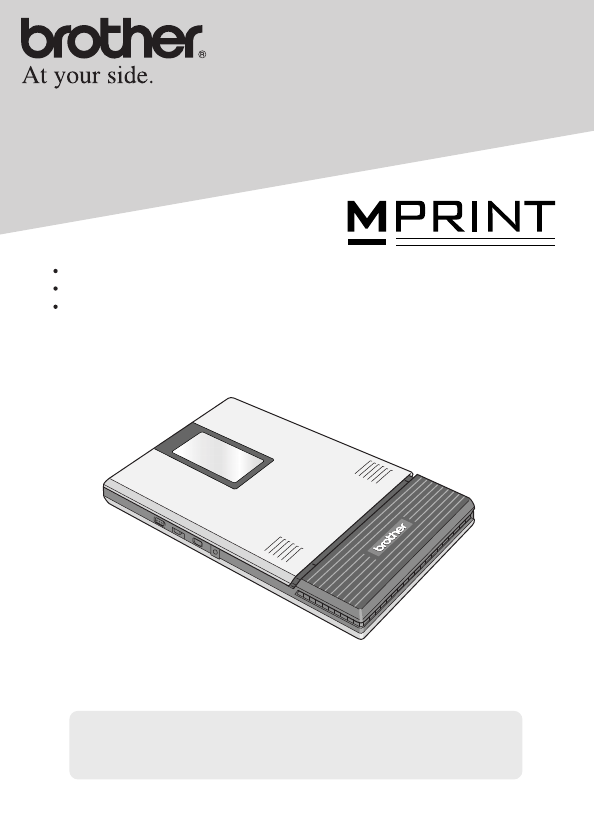
!
Before using this printer, be sure to read this User’s Guide.
!
We suggest that you keep this manual in a handy place for future
reference.
User’s Guide
General Description
Operating Procedures
Appendix, etc.
MW-260
Mobile Printer

Introduction
i
Thank you for purchasing the MPrint MW-260 (hereafter referred
to as “the printer”).
This monochrome thermal mobile printer is ultra-portable and
can be connected to a Pocket PC (PDA running Pocket PC) or a
computer to make quick printouts.
This User’s Guide contains operating precautions and instruc-
tions. Before using this printer, be sure to read this manual for
information on its correct operation.
In addition, we suggest that you keep this manual in a handy
place for future reference.
Introduction
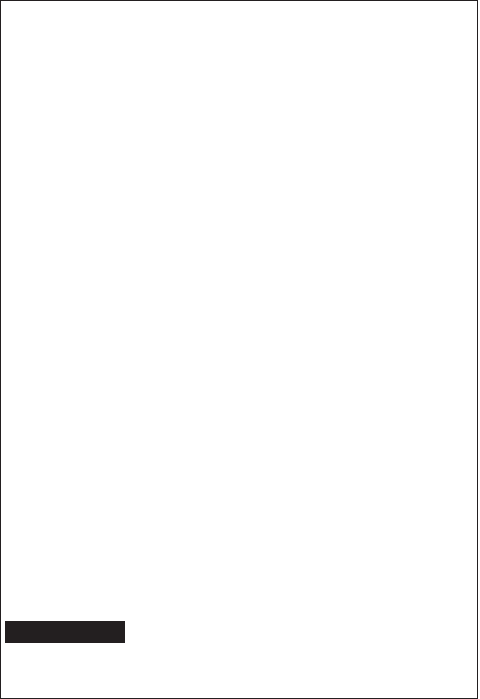
ii
Federal Communications Commission (FCC) Declaration of Conformity (For USA Only)
Responsible Party
:
Brother International Corporation
100 Somerset Corporate Boulevard Bridgewater, NJ 08807-0911 USA
TEL : (908) 704-1700
declares that the product
Product Name : Brother MPrint MW-260
Model Number : MW-260
complies with Part 15 of the FCC Rules. Operation is subject to the
following two conditions: (1) this device may not cause harmful inter-
ference, and (2) this device must accept any interference received,
including interference that may cause undesired operation.
This equipment has been tested and found to comply with the
limits for a Class B digital device, pursuant to Part 15 of the
FCC Rules. These limits are designed to provide reasonable
protection against harmful interference in a residential installa-
tion. This equipment generates, uses, and can radiate radio fre-
quency energy and, if not installed and used in accordance with
the instructions, may cause harmful interference to radio com-
munications. However, there is no guarantee that interference
will not occur in a particular installation. If this equipment does
cause harmful interference to radio or television reception,
which can be determined by turning the equipment off and on,
the user is encouraged to try to correct the interference by one
or more of the following measures:
-Reorient or relocate the receiving antenna
-Increase the separation between the equipment and receiver.
-Connect the equipment into an outlet on a circuit different from
that to which the receiver is connected.
-Consult the dealer or an experienced radio / TV technician for
help.
-Changes or modifications not expressly approved by Brother
Industries, Ltd. could void the user's authority to operate the
equipment.
FCC WARNING
-This device complies with FCC RF radiation exposure limits
set forth for an uncontrolled environment. The antenna used
for this transmitter must be installed to provide a separation
distance of at least 20 cm from all persons and must not be
co-located or operating in conjunction with any other antenna
or transmitter.

Introduction
iii
!
The contents of this manual are subject to change without notice.
!The contents of this manual may not be duplicated or repro-
duced, partially or in full, without permission.
!Please note that we assume no responsibility for damages
arising from earthquakes, fire, other disasters, actions of third
parties, the user’s intentional or negligent operation, misuse or
operation under other special conditions.
!Please note that we assume no responsibility for damage
(such as losses, loss of business profits, lost profits, business
disruptions or a lost means of communication) that may result
from the use or inability to use this printer.
!If this printer should be defective due to faulty manufacturing,
we shall replace it during the warranty period.
!We assume no responsibility for damages that may result from
incorrect operation of this printer by connecting incompatible
equipment or using incompatible software.
CAUTION
RISK OF EXPLOSION IF BATTERY IS REPLACED BY AN
INCORRECT TYPE.
DISPOSE OF USED BATTERIES ACCORDING TO THE
INSTRUCTIONS.
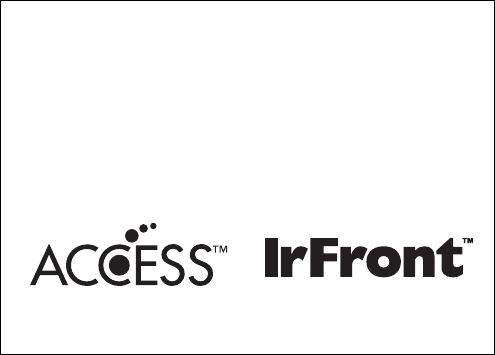
iv
!Microsoft® and Windows® are registered trademarks of
Microsoft Corporation in the United States and other countries.
!
The Bluetooth
®
word mark and logos are owned by the Bluetooth
®
SIG, Inc. and any use of such marks by Brother Industries, Ltd.
under license.
!This product contains IrFront of ACCESS CO., LTD.
Copyright (C) 1996-2006 ACCESS CO., LTD.
!ACCESS and IrFront are trademarks or registered trademarks
of ACCESS CO., LTD. in Japan and other countries.
!All other software and product names mentioned are trade-
marks or registered trademarks of their respective companies.
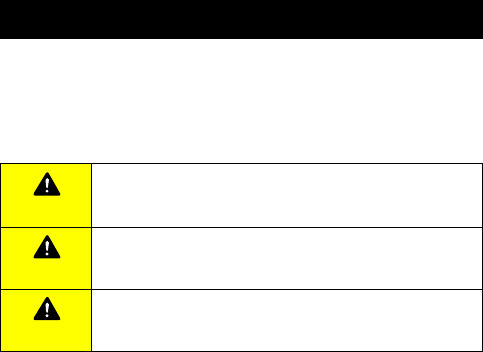
Precautions
v
Precautions indicated as shown below contain important safety
information and should be strictly observed.
If the printer malfunctions, immediately stop using it, and then
contact the sales representative where it was purchased.
The meanings for marks used in this manual are described below
.
Precautions
Danger
Failure to accurately observe instructions marked with
this symbol lead to an extremely high risk of death or
serious injuries.
Warning
Failure to observe instructions marked with this symbol
may result in death or serious injuries.
Caution
Failure to observe instructions marked with this symbol
may result in injuries or property damage.
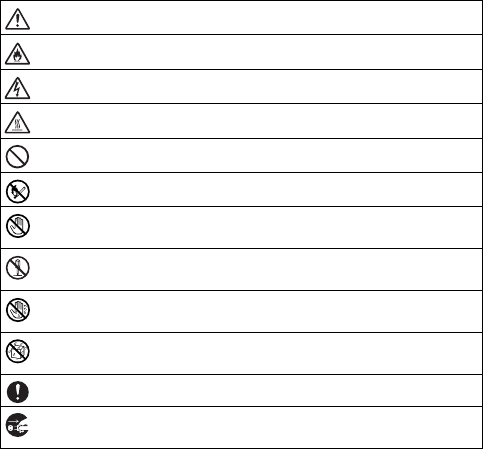
vi
Meanings for symbols used in this manual
Indicates danger
Indicates danger of fire under certain circumstances
Indicates danger of electric shock under certain circumstances
Indicates danger of burns under certain circumstances
Indicates an action that must not be performed
Indicates danger of combustion if fire is nearby
Indicates danger of sustaining injuries if the indicated part of the
printer is touched
Indicates danger of injuries, such as electric shock, if the indi-
cated part if the printer is disassembled
Indicates danger of electric shock if the operation is performed
with wet hands
Indicates danger of electric shock if the printer is exposed to
water
Indicates an action that must be performed
Indicates that the power supply cord must be unplugged from the
electrical outlet
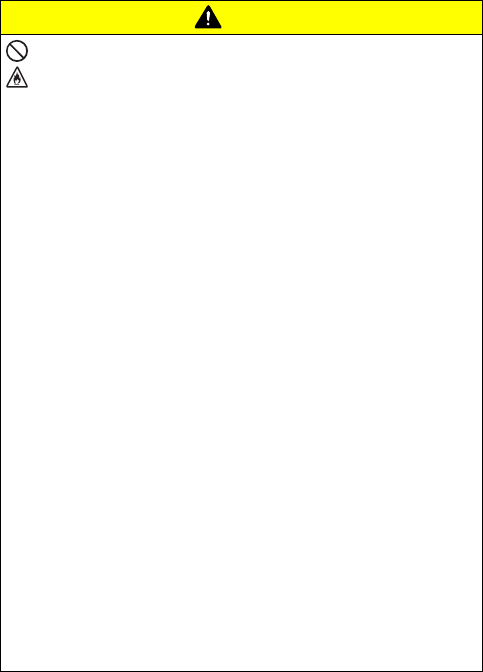
Precautions
vii
Concerning this printer (Recharge Lithium-ion Battery
)
Danger
!
Do not use this printer with any rechargeable battery other than
that specified, otherwise a fire or an electric shock may result.
!
Carefully observe the following precautions for the
rechargeable lithium-ion battery (BT-200; hereafter, referred to
as “rechargeable battery”) included with the printer, otherwise
heat or cracks may be produced, or a fire, an electric shock or
damage may result.
!
To recharge the battery, insert the rechargeable battery
into the MW-260, and then use the AC adapter designed
specifically for this printer.
!
Do not insert or use the rechargeable battery in any equip-
ment other than the MW-260. Do not directly connect it to
a power supply, car cigarette lighter or electrical outlet.
!
Do not expose the rechargeable battery or the printer with the
rechargeable battery installed to pressure, heat or an electric
charge (for example, an oven or microwave oven, clothes
dryer, high-voltage equipment or electromagnetic cooker).
!
Do not place the rechargeable battery or the printer with
the rechargeable battery installed near a fire or in a loca-
tion exposed to heat or high temperatures (for example,
near a flame or stove, in the sun, or in a location where
the temperature is 60 °C or more, such as in a hot car).
!
Do not place the rechargeable battery or the printer with the
rechargeable battery installed near water or seawater. In
addition, do not drop them in water or allow them to get wet.
!
Do not short-circuit the terminals of the rechargeable bat-
tery or the printer with the rechargeable battery installed,
such as with a metal object.
!
Do not pierce or poke a hole in the rechargeable battery
or the printer with the rechargeable battery installed with
a sharp object, such as a nail.
!
Do not hit with a hammer, step on, throw, drop or apply a
strong shock to the rechargeable battery or the printer
with the rechargeable battery installed.
!
Do not disassemble or alter the rechargeable battery or
the printer with the rechargeable battery installed.
!
Do not use a damaged or deformed rechargeable battery.
!
Do not use in a corrosive environment (for example, exposed
to salty air or salt water, or acidic, alkaline or corrosive gas).
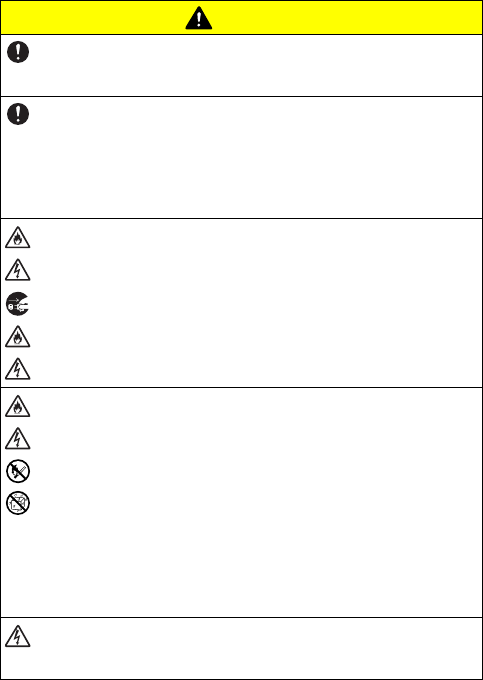
viii
Warning
!
Do not use this printer wherever it is prohibited, for exam-
ple, on an airplane, otherwise it may affect equipment,
resulting in an accident.
!
If this printer is to be used in special environments, for
example, near medical equipment, make sure in advance
that there would be no harmful effects from electromag-
netic waves. Please note that we assume no responsibility
for injuries resulting from interference from electromagnetic
waves.
!
Do not insert foreign objects into the printer or its connec-
tors and ports, otherwise a fire, an electric shock or dam-
age may result.
!
If foreign objects are dropped into the printer, immediately
turn it off, unplug the AC adapter from the electrical outlet,
and then contact the sales representative where it was pur-
chased. If you continue to operate the printer, a fire, an
electric shock or damage may result.
!
Do not operate, recharge or store the printer in the follow-
ing locations, otherwise it may leak or fire, electric shock or
damage may result.
!
Near water, such as in a bathroom or near a water
heater, or in an extremely humid location
!
In a location where it is exposed to rain or moisture
!
In an extremely dusty location
!
In an extremely hot location, such as naked flames, or
heaters or direct sunlight
!
In a closed car under a hot sun
!
In a location where condensation may form
!
When lightening is seen, unplug the AC adapter from the
electrical outlet. If lightening hits nearby, do not touch the
printer, since there is a chance of electric shock.
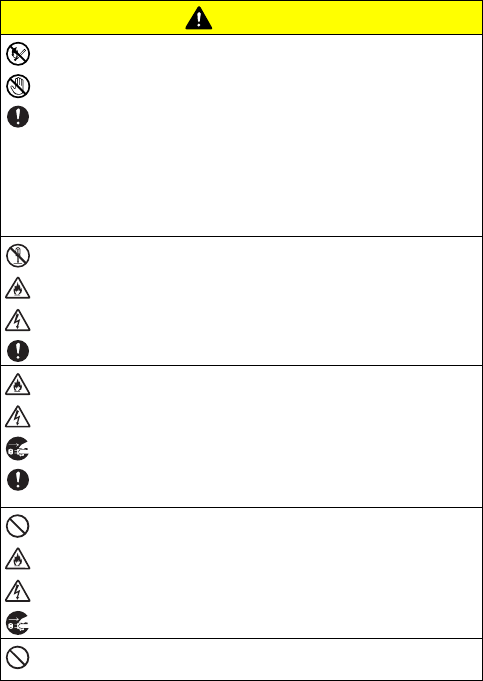
Precautions
ix
!
Liquid leaking from the printer or rechargeable lithium-ion
battery may indicate that the rechargeable battery is dam-
aged. Immediately move the printer or rechargeable bat-
tery away from flames to avoid the risk of a fire.
In addition, do not touch the leaking liquid. This liquid may
damage your eyes or skin if brought in contact with them. If
the liquid contacts your eyes, immediately rinse them with
water and consult a medical professional. If the liquid con-
tacts your skin or clothing, immediately rinse them with
water. Place the printer in a bag to isolate it.
!
Do not try to disassemble or alter this printer, otherwise
fire, electric shock or damage may result. For servicing,
adjustments or repairs, contact the sales representative
where it was purchased. (The warranty does not cover
repairs for damage resulting from disassembly or alter-
ations performed by the user.)
!
The printer may be damaged if it is dropped or subjected to
strong shocks, for example, from being stepped on. If you
continue to operate a damaged printer, a fire or an electric
shock may result. If the printer is damaged, immediately
turn it off, unplug the AC adapter from the electrical outlet,
and then contact the sales representative where it was pur-
chased.
!
If the printer operates abnormally, for example, if it pro-
duces smoke, an unusual odor or an unusual noise, stop
using it, otherwise fire, electric shock or damage may
result. Immediately turn off the printer, unplug the AC
adapter from the electrical outlet, and then contact the
sales representative where it was purchased for repairs.
!
Do not charge the printer with a charger other than that
specified.
Warning
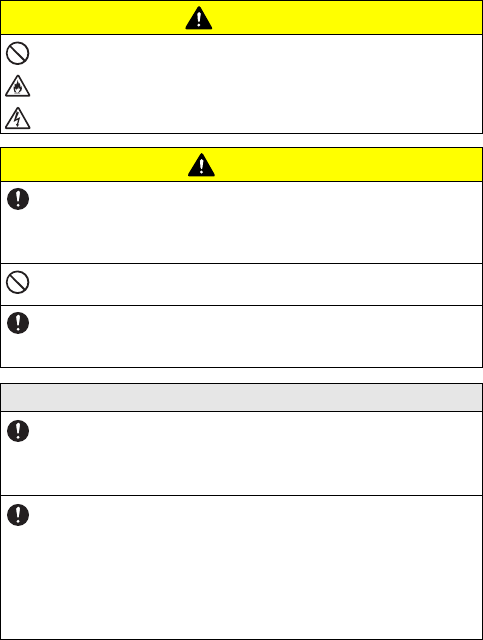
x
!
If the printer is not fully charged after the specified amount
of time has passed, stop charging it, otherwise fire, electric
shock or damage may result.
Caution
!
Keep the printer and its accessories (rechargeable battery,
consumables, plastic bags, labels, etc.) out of the reach of
children, particularly infants, otherwise injuries or accidents
(such as ingestion) may result.
!
Stop operating the printer if it leaks or becomes discolored,
deformed or otherwise defective.
!
Do not operate the printer while holding only the paper cas-
sette cover. If the cover comes off and the printer falls, inju-
ries may result.
Others
!
The Recharge Lithium-ion Battery is slightly charged so
that the operation of the printer can be verified; however,
the battery should be fully charged with the AC adapter
before the printer is used.
!
If the printer will not be used for a long period of time,
remove the rechargeable lithium-ion battery from the
printer, and then store it in a location where it is not
exposed to high humidity, high temperatures (15 °C / 59°K
or less is recommended) or static electricity. In order to
maintain the efficiency and life of the rechargeable lithium-
ion battery, recharge it at least every six months.
Warning
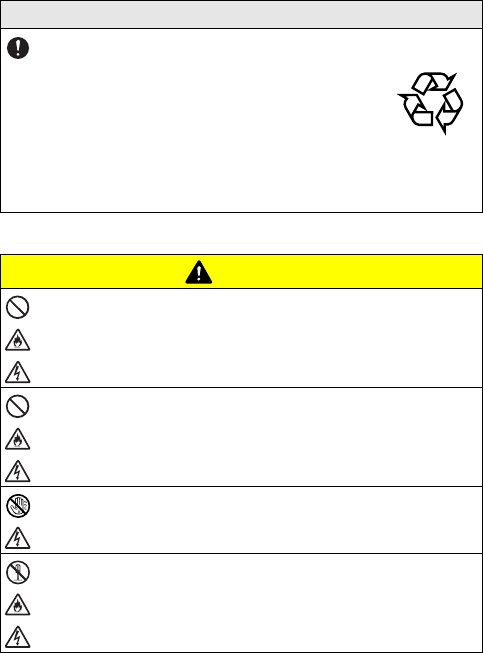
Precautions
xi
Concerning the AC adapter
!
This printer is powered with a Recharge Lith-
ium-ion Battery. If this printer can only be used
for a short period of time, even though it is
fully charged, the battery may have reached
the end of its service life. Replace the
Recharge Lithium-ion Battery with a new one.
When replacing the battery, disconnect it by
affixing tape to the terminals that contact the
printer.
Warning
!
Only use the AC adapter designed specifically for this
printer, otherwise fire, electric shock or damage may result.
!
Do not plug the printer into an electrical outlet other than a
household outlet (AC 110 V
–
120 V), otherwise fire, elec-
tric shock or damage may result.
!
Do not touch the AC adapter or the power supply plug with
wet hands, otherwise electric shock may occur.
!
Do not try to disassemble, alter or repair the AC adapter,
otherwise fire, electric shock or injuries may result.
For servicing, adjustments or repairs, contact the sales
representative where the printer was purchased.
Others
Li-ion
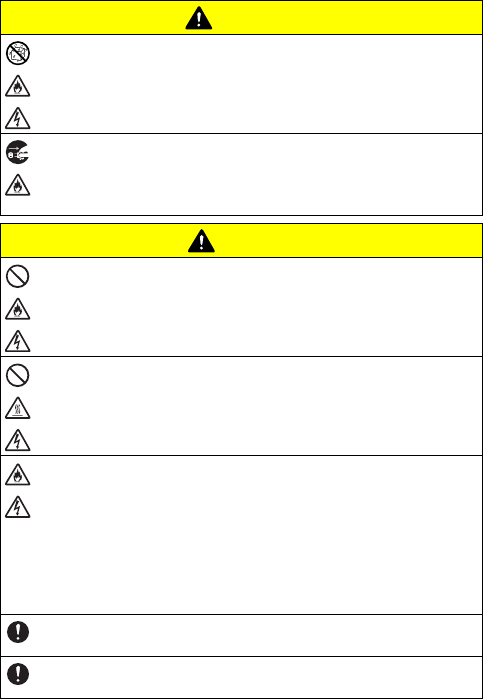
xii
!
Do not spill water or drinks, such as coffee or juice, on the
AC adapter. In addition, do not use the adapter in a loca-
tion where it may get wet, otherwise combustion or electric
shock may result.
!
If the power supply plug becomes dirty, for example, with
dust, unplug it from the electrical outlet, and then wipe it
with a dry cloth. If you continue to use a dirty power supply
plug, a fire may result.
Caution
!
When unplugging the power supply cord, do not pull on the
cord, otherwise fire or electric shock may result.
!
Do not insert foreign objects into the terminals of the AC
adapter, otherwise burns or electric shock may result.
!
Incorrectly using the AC adapter may result in fire or
electric shock. Therefore, observe the following precau-
tions.
!
Do not damage it.
!
Do not place objects on it.
!
Do not modify it.
!
Do not subject it to heat.
!
Do not twist it.
!
Do not bind it.
!
Do not severely bend it.
!
Do not allow it to be
!
Do not pull on it. pinched.
!
If the AC adapter is damaged, request a new one from the
sales representative where the printer was purchased.
!
Keep the AC adapter out of the reach of children, particu-
larly infants, otherwise injuries may result.
Warning
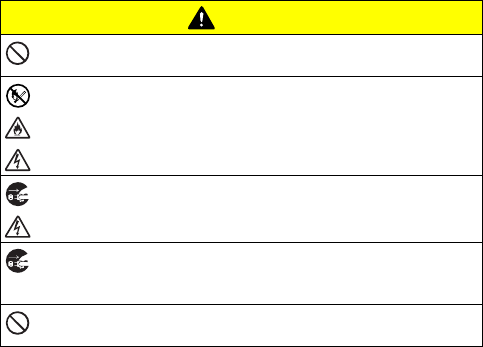
Precautions
xiii
!
Do not use the AC adapter near microwave ovens, other-
wise damage may result.
!
Do not use the AC adapter near flames or heaters. If the
covering of the AC adapter cord melts, fire or electric shock
may result.
!
Before maintaining the printer, for example, when cleaning
it, unplug the AC adapter from the electrical outlet, other-
wise electric shock may result.
!
If the printer is not to be used for a long period of time, be
sure to unplug the AC adapter from the unit and the electri-
cal outlet for safety reasons.
!
Do not wind the AC adapter cable around the adapter or
bend the cable, otherwise the cable may be damaged.
Caution

xiv
Operating precautions
" Operate this printer in an environment that meets the follow-
ing requirements.
!Temperature: 0
–
40°C / 32
–
104°K
!
Humidity: 20 – 80 % (Maximum wet-bulb temperature: 27 °C)
!Do not operate or store this printer in a location exposed to
extremely high or extremely low temperatures, extreme
humidity, extreme dust, or extreme vibrations, otherwise
the printer may be damaged or malfunction.
!Do not use the printer in a location exposed to extreme tem-
perature fluctuations, otherwise condensation may occur,
resulting in the printer being damaged or malfunctioning.
!If condensation occurs, allow it to dry naturally before
operating the printer.
!This printer uses a lithium-ion battery. Due to the character-
istics of lithium-ion batteries, using them in locations at low
temperatures may greatly reduce the number of prints pos-
sible.
"The AC adapter case and the printer may become hot while
the printer is charging or printing. This does not indicate a
malfunction.
"When the printer is not used, unplug the power supply plug
from the electrical outlet.
"Do not block the paper output slot.
"If the AC adapter connector or USB port becomes dirty, incor-
rect connection or incorrect charging may result. Periodically
clean the connector and port with a dry cotton swab.
"When cleaning the printer, use a soft, dry cloth. Do not use
benzene or paint thinners, otherwise the printer may become
discolored or deformed. (→ Refer to page 17.)
"When using optional accessories, use them as described in
their instruction manuals.
Precautions
xv
"Use thermal paper with this printer. If printed text is written
over or stamped, the text may disappear or become discol-
ored. In addition, it may take some time for the ink to dry.
"Do not touch the printer with wet hands.
"Do not press the power button with a sharp object such as a
pen, otherwise the power button may become indented or the
machine may be damaged.
"Do not carry around the printer with the USB cable or power
cable connected, otherwise the cable connectors may be
damaged.
"Do not leave paper cassette cover open when storing as this
may cause paper misfeeding or a paper sensor error.
"Concerning the paper cassette and the handling of the paper
!Store the paper cassette away from extremely hot,
extremely humid or extremely dusty locations and out of
direct sunlight, otherwise the paper may become discol-
ored or a malfunction may result.
!Be sure to close the lid of the paper cassette before storing
it, otherwise the paper may become discolored.
!Do not leave paper cassettes in a closed car under a hot
sun, otherwise they may become discolored.
!After opening the package of paper cassettes, close it
again as soon as possible, otherwise the paper may
become discolored.
!Do not use paper that has been exposed to condensation.
!Do not try to use paper transferred from one paper cas-
sette to another, otherwise a malfunction may result.
!Do not try to reuse paper that has already passed through
the printer, otherwise a malfunction may result.
!Do not open the paper cassette cover or pull out or push in
the paper while the printer is printing, otherwise a malfunc-
tion may result.
!Do not use folded, curled, cut, wet or damp paper, other-
wise a paper misfeed or a malfunction may result.
xvi
!Do not touch paper cassettes or paper with wet hands,
otherwise a malfunction may result.
!Do not prepare or replace the paper cassette in an
extremely humid location, otherwise a malfunction may
result.
!Depending on the environmental conditions of the location
and the quality of the material that the adhesive-backed
paper is attached to, the adhesive-backed paper may
become discolored, peel off, be difficult to remove, leave
adhesive behind or damage the surface that it was affixed
to. Before using the adhesive-backed paper, test it by affix-
ing a small piece to an inconspicuous area of the intended
surface.
!Do not affix the adhesive-backed paper to people, animals
or plants. Also, do not affix it to public property or other
peoples possessions without permission.

Contents
1
Introduction .......................................................... i
Precautions .......................................................... v
Operating precautions ............................................ xiv
Contents ............................................................... 1
1 General Description ........................................ 2
2 Operating Procedures .................................... 3
Removing the protective film .....................................3
Inserting/removing the rechargeable battery .............3
Charging ....................................................................4
Using IrDA (infrared) ..................................................6
Using Bluetooth .........................................................6
Turning on/off the printer ...........................................7
Bluetooth Functions Guide ........................................8
Preparing the paper ...................................................9
Installing the paper cassette ....................................11
Sending data from a Pocket PC or computer ..........13
Feeding paper .........................................................15
Using the paper guide .............................................16
Maintenance ............................................................17
3 Appendix ........................................................ 19
Product specifications .............................................19
Troubleshooting .......................................................20
Indicator lights .........................................................24
Contents
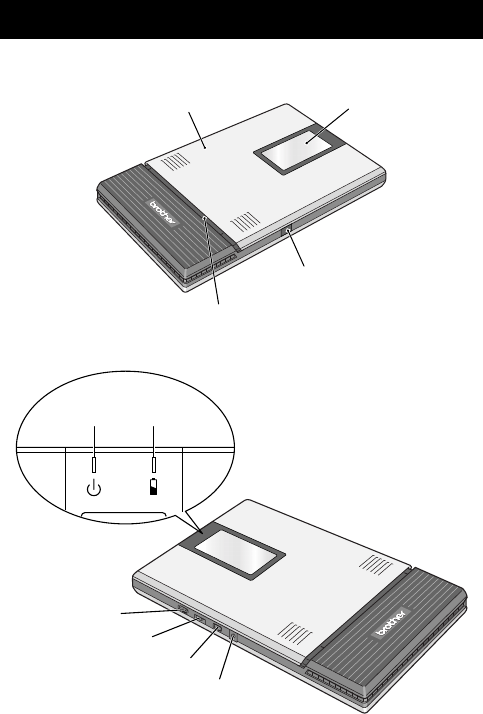
2
Right side
Left side
1 General Description
Paper cassette cover
Paper check window
Paper output slot
IrDA Port
Status
indicator light
AC adapter connector
Power button
USB port
Charging
indicator light
Interface switch
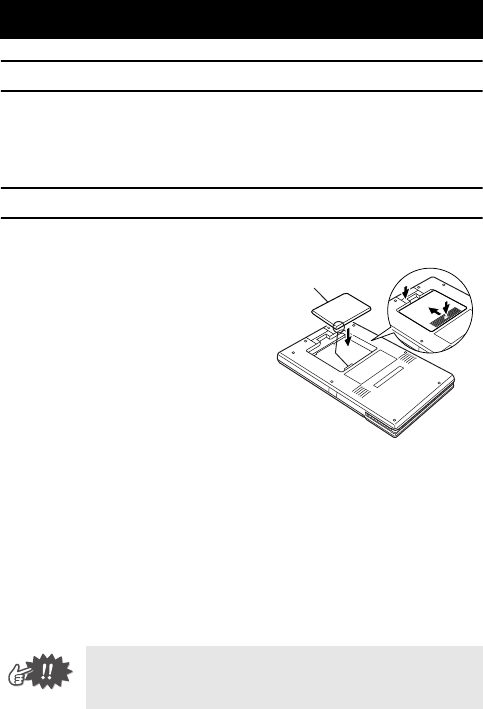
Operating Procedures
3
Removing the protective film
When shipped from the manufacturer, a protective film is affixed
to the paper check window. Before using the printer, remove the
protective film.
Inserting/removing the rechargeable battery
Inserting the rechargeable battery
1
Slide the rechargeable
battery cover (at the
back of the printer) in the
directions shown at
a
.
2
Insert your finger at
b
, and
then remove the cover and
battery.
3
Align the battery with the
connector (c), and then
install the rechargeable
lithium-ion battery.
4
Perform step 2, then step 1 to attach the cover.
Removing the rechargeable battery
1
Slide the rechargeable battery cover (at the back
of the printer) in the directions shown at a.
2
Insert your finger at
b
, and then remove the cover
.
3
Perform step 2, then step 1 to attach the cover.
2 Operating Procedures
#When handling the rechargeable battery, refer to
and observe the precautions on page x.
Lithium-ion battery
c
a
b
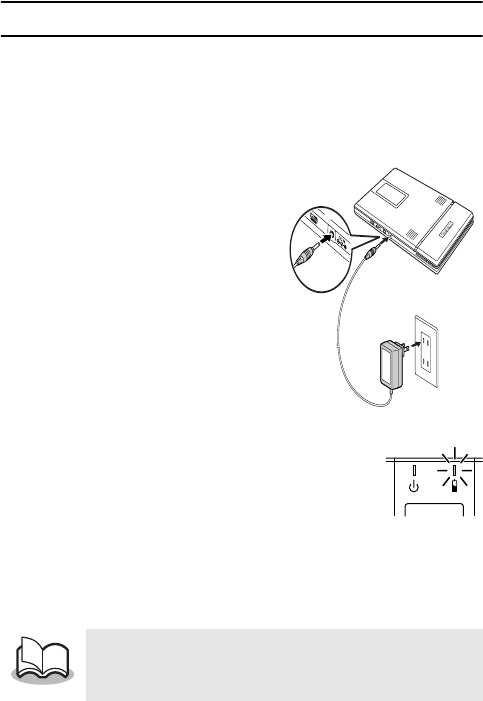
4
Charging
This printer is equipped with a
lithium-ion battery
. Use the AC
adapter designed specifically for this printer to charge the bat-
tery.
After purchasing this printer, be sure to charge the battery fully
before using it.
1
Plug the AC adapter
cable into the AC
adapter connector on the
printer.
2
Plug the AC adapter plug
into a household electri-
cal outlet (AC 110V-
120V).
Charging of the lithium-ion
battery automatically begins.
→The charging indicator light comes on in
orange.
→When charging is finished, the charging
indicator light goes off.
→
If the charging indicator does not light up
in orange, the battery may not be correctly installed.
3
After charging is finished, disconnect the AC
adapter.
#
MW-260 cannot be operated only with the AC
adapter if the rechargeable lithium-ion battery is not
installed.
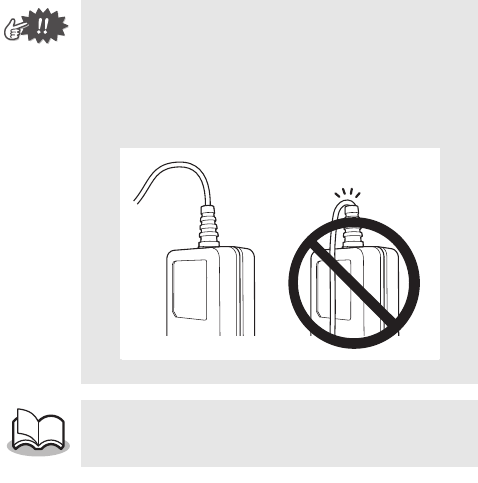
Operating Procedures
5
•In order to protect the circuitry, the battery cannot
be charged if the unit is in a location exposed to
extremely high or extremely low temperatures.
•
Do not wind the AC adapter cable around the adapter
or bend the cable, otherwise the cable may be dam-
aged.
•It takes approximately three hours for the battery
to be recharged from completely empty to fully
charged (with the printer turned off).
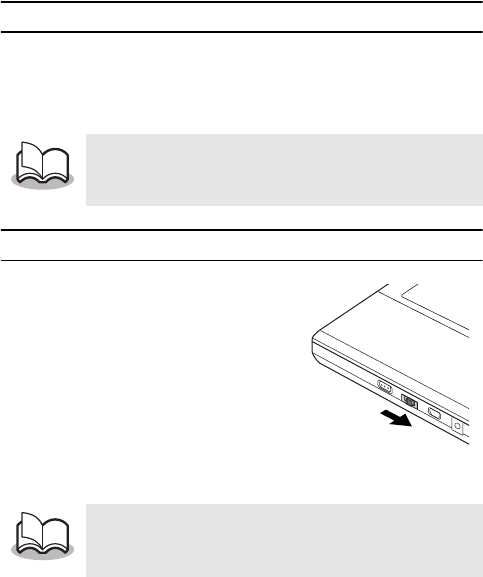
6
Using IrDA (infrared)
1
Set the interface switch to “IrDA” (infrared).
→When the printer is turned on, the status indicator lights
up in green.
Using Bluetooth
1
Set the interface switch to
“Bluetooth”.
→When the printer is turned
on, the status indicator lights up in blue.
#When “IrDA” (infrared) is selected, Bluetooth can-
not be used.
#When “Bluetooth” is selected, IrDA (infrared) can-
not be used.
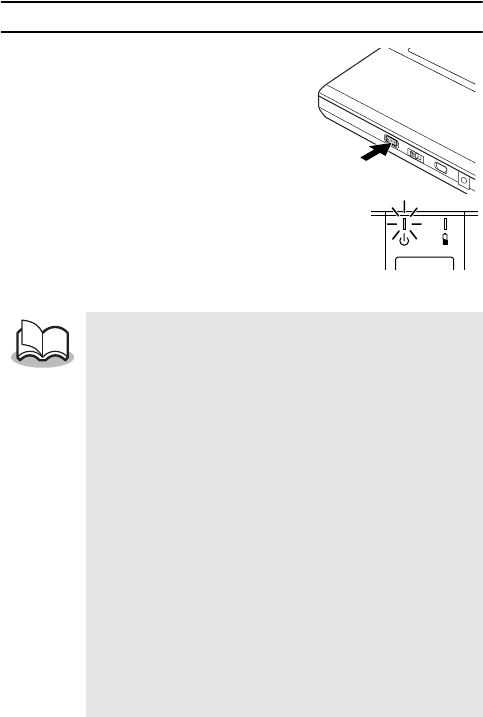
Operating Procedures
7
Turning on/off the printer
1
Press and hold the power
button for a short while, until
the green or blue status indi-
cator light illuminates.
→When the printer is turned on, the sta-
tus indicator lights up in blue (when
the interface switch is set to “Blue-
tooth”) or it lights up in green (when
the interface switch is set to “IrDA”).
(→Refer to page 24.
)
#In order to prevent this printer from accidentally
being turned on, it does not come on if the power
button is lightly pressed. Therefore, if the printer
does not come on, hold the power button pressed
for a short while.
#In order to conserve power from the rechargeable
lithium-ion battery, the following printer functions
are performed during operation.
#When the interface switch is set to “Bluetooth”:
If there is no operation or data transmission for a
set length of time, the printer automatically enters
the sleep mode. (→ page 24) The length of time
until the printer automatically enters the sleep
mode can be specified from the utility.
(→ Refer to the Software Guide.)
#When the interface switch is set to “IrDA”:
If there is no operation or data transmission for a
set length of time, the printer automatically turns
off. The length of time until the printer automati-
cally turns off can be specified from the utility.
(→ Refer to the Software Guide.)

8
Bluetooth Functions Guide
1) What is Bluetooth?
Bluetooth is a type of short-range wireless technology that
provides wireless connectivity to users of computers and
PDAs equipped with Bluetooth.
2) Precautions for using Bluetooth
Wireless connections are used in a wide range of fields.
Therefore, in order to prevent malfunctions with the follow-
ing, Bluetooth should be turned off.
• Hospitals
• Aircraft
• Gasoline/Petrol stations
• Fire alarms
3) For better transmission
Bluetooth connectivity varies greatly according to its oper-
ating environment.If a good connection cannot be
achieved, try conecting again.Connections are difficult to
achieve in the following locations.
• Near electronic equipment
• Near broadcasting stations or wireless base sta tions
• Near wireless LAN (IEEE802.11)
4) Other features of Bluetooth technology
• Equipment using Bluetooth technology may require a few
seconds until theBluetooth function can be used after it is
turned on. This length of time differs depending on the
equipment. (This unit requires a maximum of 8 seconds.)
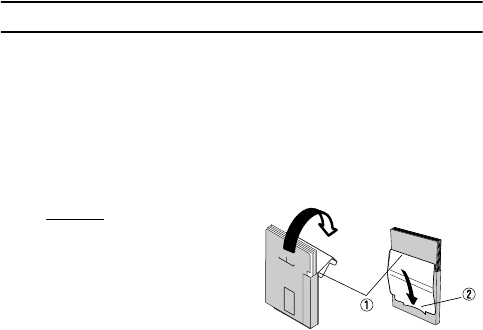
Operating Procedures
9
Preparing the paper
Use only the paper cassette designed exclusively for this printer.
Use of any other paper will result in damage.
To prepare the paper cassette
Prepare the paper cassette before installing it into the printer.
•Be careful not to drop any paper while the paper cassette is being
prepared
.
1
Firmly
fold the lid back
along the fold (
1
).
2
Insert the tab on the lid
into the slit (2) at the back of the cassette.
Front Back
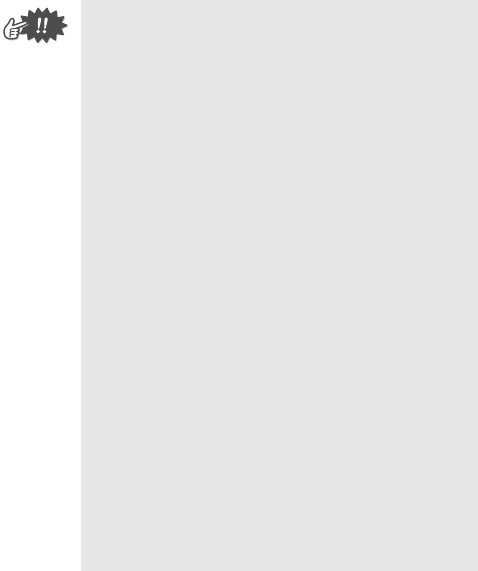
10
" Handling the paper cassette
!This printer determines the paper type depending
on the installed paper cassette, then automati-
cally selects the settings appropriate for that type
of paper. Do not transfer paper to a different
paper cassette.
!Do not try to reuse paper that has already passed
through the printer.
!The paper cassette is made of cardboard. After
all of the paper is used, dispose of the cassette
according to local regulations.
!Do not use a torn or deformed paper cassette,
otherwise damage may result.
!Do not prepare the paper cassette in an
extremely humid location, otherwise a malfunc-
tion may result.
!Do not touch paper cassettes or paper with wet
hands, otherwise a malfunction may result.
!Store the paper cassette out of extremely hot,
extremely humid or extremely dusty locations and
out of direct sunlight.
!When storing the paper cassette, be sure to close
its lid.
!Do not leave paper cassettes in a closed car
under a hot sun.
!Use the paper as quickly as possible, otherwise it
may become discolored.
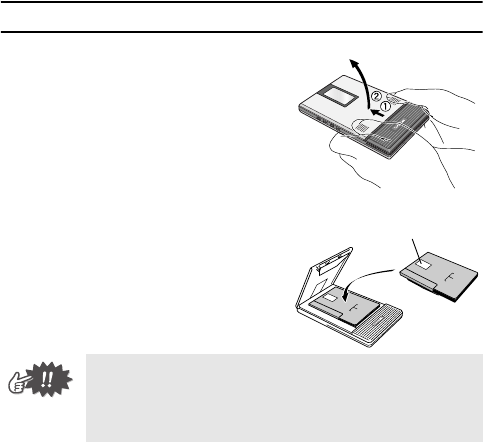
Operating Procedures
11
Installing the paper cassette
1
Slide the paper cassette
cover (on the top of the
printer) in direction 1.
→The paper cassette cover
will open in the direction
indicated by 2.
2
Insert the paper cassette.
The paper type indication on the
paper cassette should face up.
The end of the paper should
point toward you.
•When loading the paper cassette, make sure that
it is correctly aligned and that the end of the
paper is not folded, otherwise a paper misfeed
may result.
Paper type indication
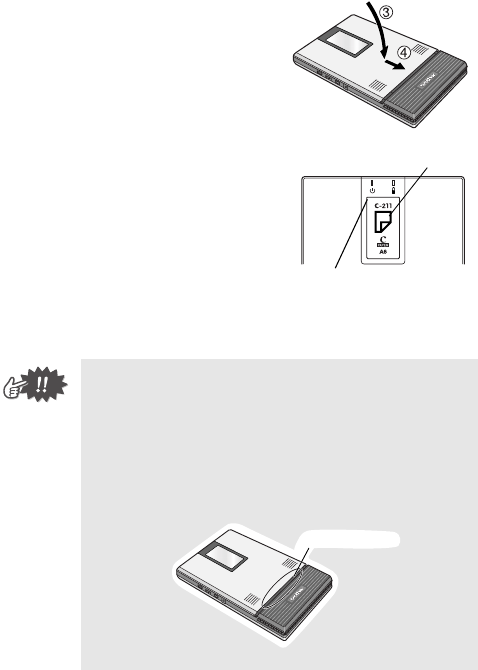
12
3
Close the paper cassette
cover in direction 3.
4
Slide the paper cassette
cover in direction 4.
If the paper cassette is correctly
loaded, the paper type indication
on the cassette can be seen
through the paper check win-
dow, and the paper cassette
cover will be locked.
•Do not remove the paper from the paper cassette
and load it directly into the printer.
•To change the paper type, install a different paper
cassette.
•While the printer is printing, do not apply pressure
to the paper output slot or place anything on the
printer.
Paper check window
Paper type indication
Paper output slot
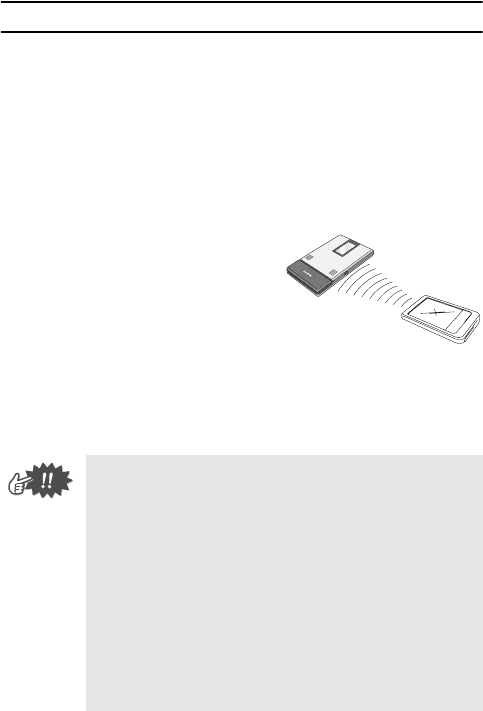
Operating Procedures
13
Sending data from a Pocket PC or computer
In order use this printer to print data from a Pocket PC (PDA run-
ning Pocket PC) or computer, the software must first be installed
onto the Pocket PC or computer as described in the ‘software
guide’ supplied with the printer.
Sending data through an IrDA connection
A Pocket PC can communicate with this printer through its IrDA
infrared port.
1
Position this printer and
the Pocket PC so that their
IrDA infrared ports are fac-
ing each other and are
positioned not more than
20 cm / 0.8” apart.
2
Start printing from the Pocket PC.
→While data is being transmitted through the IrDA infra-
red port, the status indicator light flashes in green.
•During transmission, do not move this printer or
the Pocket PC.
•Make sure that there are no obstacles between
this printer and the Pocket PC.
•If this printer is connected with a USB cable or if
the Pocket PC is connected through a serial con-
nection, the infrared transmission cannot be
used.
•IrDA infrared transmission is not possible with
computers.
•For more details, refer to the instruction manual
for the Pocket PC.
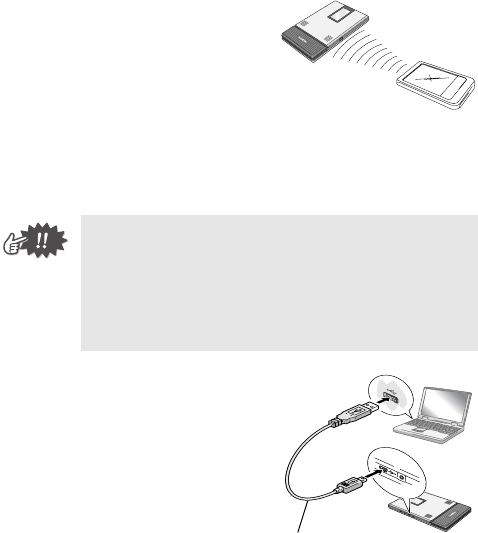
14
Communicating with Bluetooth
This printer can connect wirelessly to Bluetooth-compatible
computers or PDAs.
1
Establish a Bluetooth con-
nection.
Use the computer or PDA set-
tings to enable Bluetooth com-
munication, and then establish
a connection with this printer.
2
Start printing.
→
While data is being transmitted, the status indicator
flashes in blue.
Sending data through a USB
connection
Using the enclosed USB cable, this
printer can be connected to a com-
puter or a Pocket PC supporting a
USB host interface.
#Bluetooth communication with this printer is not
possible if this printer is already communicating
with a different computer or PDA using either
USB or Bluetooth.
#For details on the Bluetooth settings, refer to the
manual for the Bluetooth device.
Enclosed USB cable
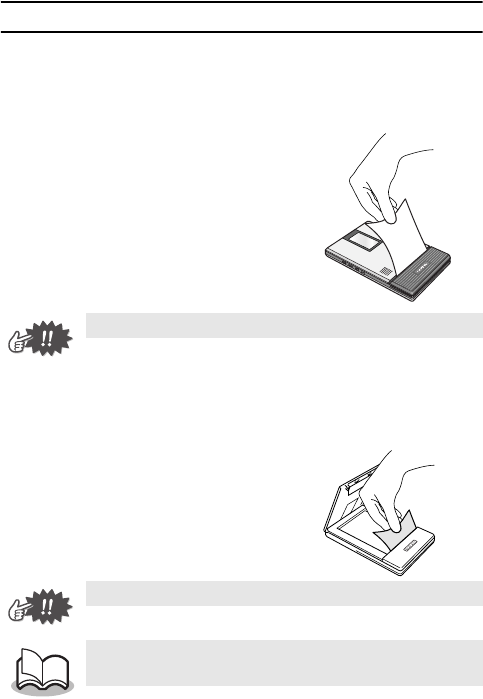
Operating Procedures
15
Feeding paper
If a paper misfeed occurs, remove the paper according to the
following procedure.
If the paper has fed out of the paper output slot:
1
Pull the paper out from the
paper output slot.
If the paper has not fed out of the paper output slot:
1
Open the paper cassette cover.
2
Remove the paper cas-
sette.
3
Pull out the misfed paper.
•When pulling out the paper, be sure not to tear it.
•When pulling out the paper, be sure not to tear it.
•Pulling out the paper will not affect the operation
of the printer.
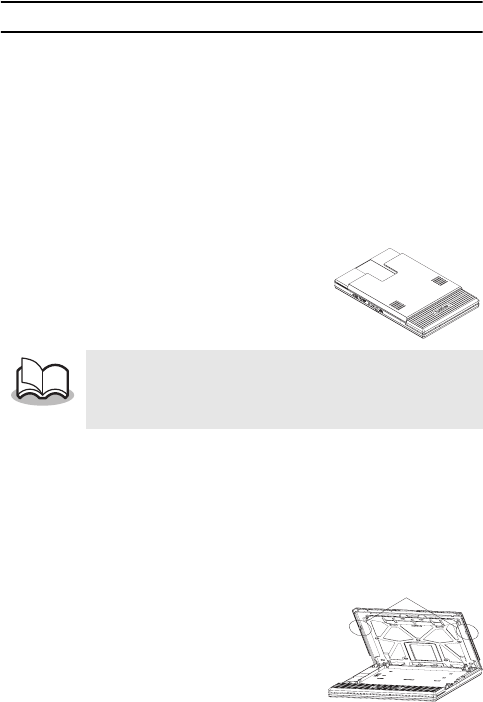
16
Using the paper guide
Installing the paper guide
*The paper guide (PG-200) is sold separately.
1
Position the paper guide so that the paper check
window is visible.
2
Align the tabs on the left and right sides with the
slots, and then press down until they snap into
place.
Removing the paper guide
1
Open the paper cassette cover.
2
One side at a time, use a standard (slotted)
screwdriver to unhook the paper guide tabs near
the areas shown by 1 below.
#The paper guide is not intended to be frequently
installed and removed. Frequently installing and
removing the paper guide may damage the
printer or cause the cover or paper guide to warp.
①
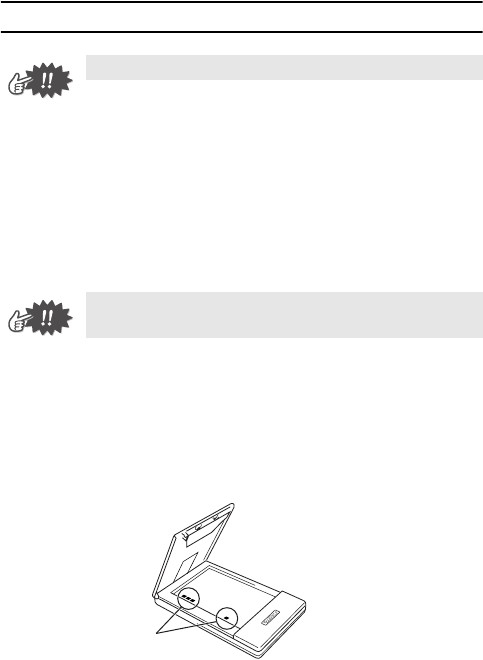
Operating Procedures
17
Maintenance
Cleaning the printer
Clean the front of the printer.
1
Clean off any dust or other dirt from the printer by
wiping it with a soft, dry cloth.
If the printer is extremely dirty, wipe it with a slightly damp
cloth.
Cleaning the sensor
If the sensor is dirty, it will not be able to correctly detect the
paper cassette, and a malfunction may result.
1
Clean the sensor with a dry cotton swab.
!Be sure to turn off the printer before cleaning it.
!Do not use benzene or paint thinners, otherwise
the printer may become discolored or deformed.
Paper cassette sensor
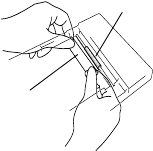
18
Cleaning the pick-up roller
If the pick-up roller is dirty, paper may not be fed correctly.
1
Affix a piece of cellophane
tape to the pick-up roller.
2
Remove the cellophane
tape from the pick-up
roller.
→Any dirt on the pick-up roller is removed with the tape.
Rotate the pick-up roller and repeat the procedure to clean
the entire surface of the roller.
Pick-up roller
Cello-
phane tape
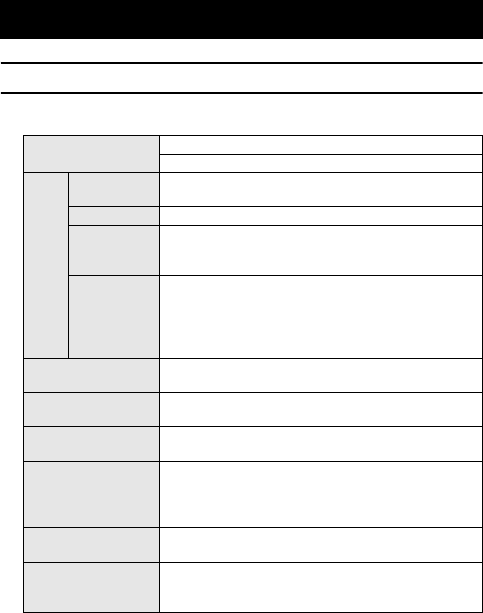
Appendix
19
Product specifications
Printer specifications
3 Appendix
Indicators Status indicator light (blue/green/red)
Charging indicator light (orange)
Printing
Method Direct thermal printing with a line thermal
print head
Resolution 300 dpi × 300 dpi
Print speed
20 seconds/sheet
(standard text on thermal paper with 7 % cov-
erage at an ambient temperature of 25 °C)
No. of
pages that
can be
printed
Up to 50 during continuous printing with a fully
charged battery. Using Bluetooth sleep mode will
affect this figure. (Based on 7 % coverage at an
ambient temperature of 25 degrees Celsius.) (Stan-
dard paper manufactured by Brother: A6 thermal)
Paper supply
method
Brother paper cassette, automatic paper
feed mechanism
Paper Brother A6 cut paper (105mm × 148mm /
4.1'' × 5.8'')
Power supply Compact switching AC adapter for charging,
lithium ion battery
Interface
Complies with USB Ver. 2.0 (Full Speed) and
compliant with Bluetooth ver. 1.1 class 2
serial port profile supported,
Compliant with
IrDA Ver.1.3
Dimensions 130mm(W) × 210mm(D) × 18.5mm(H) /
5.1''(W) × 8.3''(D) × 0.7''(H)
Weight
520g / 1.15lb (recharge lithium-ion battery
and a paper cassette containing 50 sheets of
plain thermal paper)
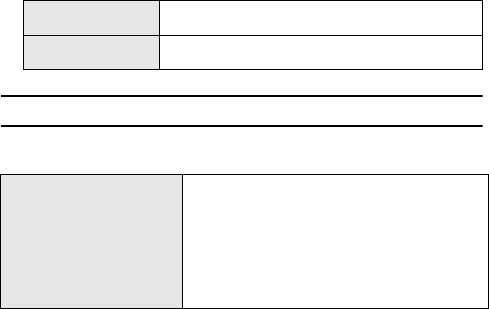
20
Paper sizes (print area)
Troubleshooting
Symptoms & remedies
Normal Type
A6 size: 105mm × 148mm / 4.1'' × 5.8''
(97.5mm × 140.6mm / 3.8'' × 5.5'')
Copying Type A6 size: 105mm × 148mm / 4.1'' × 5.8''
(93mm × 137mm / 3.6'' × 5.4'')
Symptom: The printer
cannot be turned on.
Remedy: Press and hold the power button
for a short while. (→ Refer to page 7.)
Remedy: The lithium-ion battery needs
recharging. (→ Refer to page 4.)
Remedy: The rechargeable lithium-ion
battery is not installed. Install the
rechargeable lithium-ion battery.
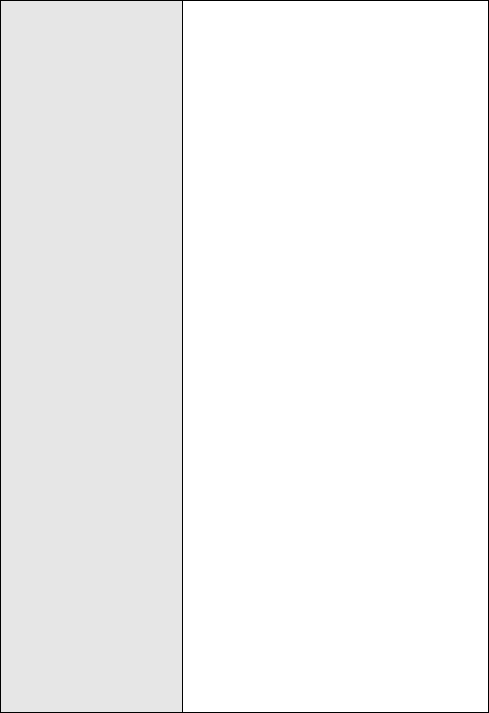
Appendix
21
Symptom: Although the
print command was
issued, the printer
does not print.
With a IrDA connection:
Remedy: Make sure that there is no obsta-
cle between this printer and the Pocket
PC or infrared communication port of
the portable telephone, and check that
they are within 20 cm of each other.
(
→
Refer to page 13.)
Remedy: Disable if the USB cable is con-
nected. (→Refer to
page 13
.)
Remedy: If the AC adapter is connected,
noise from the household electrical
outlet may be stopping the communi-
cation. Unplug the AC adapter.
Remedy: When the interface switch is set
to “Bluetooth”, IrDA cannot be used.
Set the switch to “IrDA” and check that
the status indicator lights up in green.
With a Bluetooth connection:
Remedy: Make sure that Bluetooth com-
munication will be valid using the set-
tings of the computer or Pocket PC.
(→ Refer to the Software Guide.)
Remedy: Make sure that another com-
puter or Pocket PC is not transmitting
data to the printer using the USB or
Bluetooth.
(→ Refer to page 14.)
Remedy: When the interface switch is set
to “IrDA”, Bluetooth cannot be used.
Set the switch to “Bluetooth” and check
that the status indicator lights up in
blue.
With a USB connection:
Remedy: Check that this printer is
securely connected to the computer
with the USB cable.
(→ Refer to page 14.)
Remedy: Make sure that another com-
puter or Pocket PC is not transmitting
data to the printer using Bluetooth.
(→ Refer to page 14.)
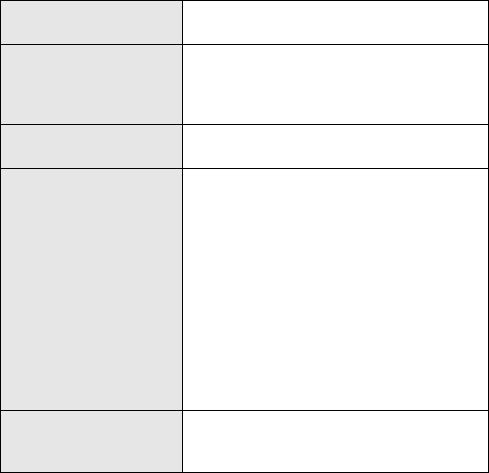
22
Symptom: There is a
paper misfeed.
Remedy: Remove the paper. (→ Refer to
page 15.)
Symptom: Even though
the misfed paper was
removed, the error
cannot be cancelled.
Remedy: Some torn paper may still
remain in the printer. Contact the sales
representative where the printer was
purchased.
Symptom: An indicator
light is lit or flashing.
Remedy: Refer to the explanation in “Indi-
cator lights” on page 24.
Symptom: The paper
does not feed.
Remedy: Make sure that the lid of the
paper cassette is firmly folded along
the fold (1). (→ Refer to page 9.)
Remedy: Make sure that the paper cas-
sette cover is securely closed.
(→ Refer to page 12.)
Remedy: The paper may be dirty. Pull out
the first sheet from the back of the
paper cassette, and then install the
paper cassette again. (→ Refer to
pages 9 and 11.)
Remedy: Clean the pick-up roller.
(→ Refer to page 18.)
Symptom: The print is
faint (light).
Remedy: Make sure that the paper cas-
sette cover is securely closed.
(→ Refer to page 12.)
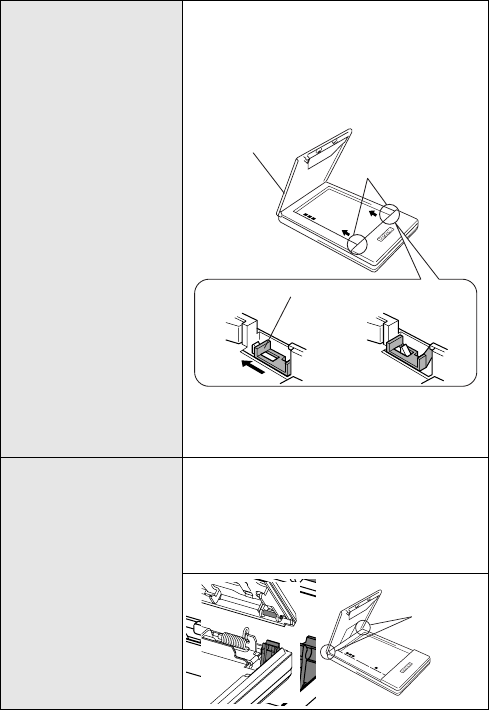
Appendix
23
Symptom: The paper
cassette cover can-
not be closed.
Remedy: The parts indicated by “A” in the
illustration below have locked up.
Refer to the illustration and use the tip of
a ball-point pen to slide the indicated part
in the direction of the arrow to free it
.
Free the part on the opposite side
using the same method
Symptom: The paper
cassette cover came
off.
Remedy: Insert the pins into the white paper
cassette cover holders (at the areas
shown by “B” below) until they snap into
place.
The pin snaps in more easily if the two
parts are angled to form a “V”.
12
Paper cassette
cover A
Push with the tip of a ball-point pen to slide it.
B
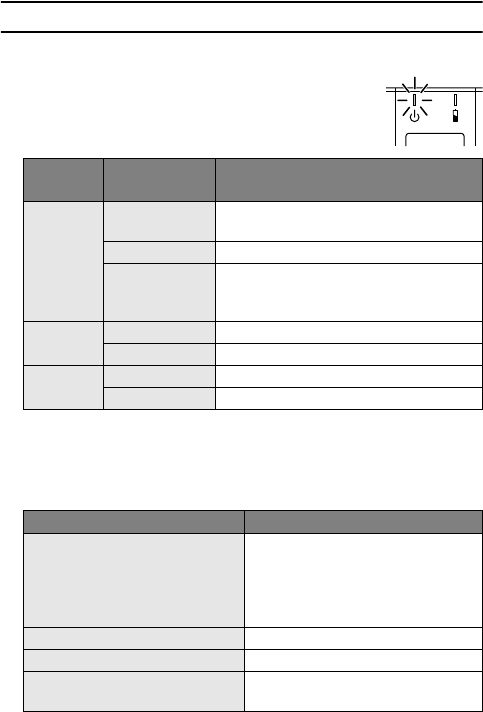
24
Indicator lights
" Status indicator light
A blue or green light indicates the printer is
operating correctly, while a red light indicates
an error has occurred.
When the status indicator light is blue, it is possible to receive data
using both the Bluetooth and USB interfaces. However, once a
connection is established using one of the interfaces, data cannot
be received using the other interface until printing is complete.
If an error has occurred, check for the following causes.
Indicator
light color
Indicator light
status Printer status
Blue
Constantly lit Waiting to receive data using Blue-
tooth or the USB
Flashing
Communicating (receiving print data)
Flashing in
long intervals
Sleep mode (power-saving standby
condition, possible only when receiving
data using Bluetooth)
Green Constantly lit
Waiting to receive data using USB or IrDA
Flashing
Communicating (receiving print data)
Red Flashing An error has occurred.
Constantly lit A system error has occurred.
Error description Remedy
There is no paper cassette
installed.
The paper cassette is installed
facing the wrong direction.
There is no more paper.
Correctly install a paper cas-
sette containing paper.
A paper misfeed occurred. Remove the misfed paper.
A transmission error occurred. Check the transmission status.
An overheat error occurred.
The inside of the printer has started
to overheat. Wait until it cools down
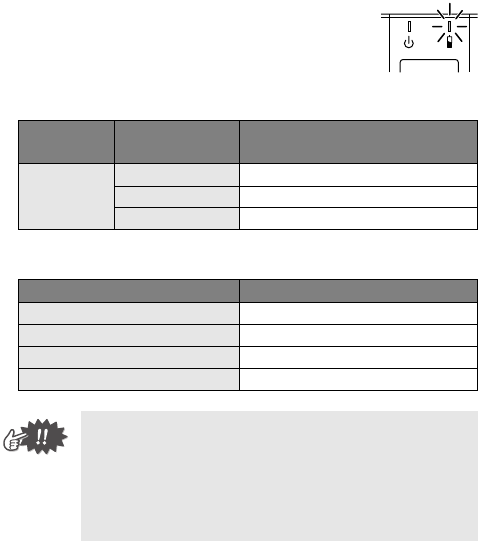
Appendix
25
If a system error has occurred:
The printer may be damaged. Contact the sales representa-
tive where it was purchased.
" Charging indicator light
With the charging indicator light, the status of
the power supply can be checked. The charg-
ing indicator light has two functions.
1 Checking the charging status (when the AC
adapter is connected)
2 Checking the battery level (while running off the lithium ion
battery)
Indicator
light color
Indicator light
status Printer status
Orange
Constantly lit Charging
Off Finished charging
Flashing Malfunctioning battery
Indicator light status Battery level
Off More than 30% charged
Flashes once Less than 30% charged
Flashes twice Less than 20% charged
Continues to flash 3 times Almost empty
•When the battery level is less than 30% charged,
recharge the battery.
•If the charging indicator light flashes while the
printer is printing, immediately connect the AC
adapter and charge the battery. The printer may
stop printing.
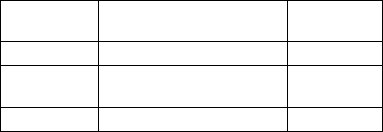
26
Glossary
Simple descriptions of terms used in this manual are provided
below. Be sure to look up any terms that you are unfamiliar with.
Bluetooth A short-range wireless communication technology
using a radio frequency; Regulated by conven-
tions called “profiles”, Bluetooth enables commu-
nication between devices with the same profile.
This printer has the serial port profile built in.
IrDA A wireless communication protocol using infrared
transmission; When infrared is used, communica-
tion is wireless; however, a line of sight to the
infrared port is required. Since the various ver-
sions (1.0, 1.1, 1.2, 1.3 and 1.4) are regulated by
the transmission distance and speed, compatibil-
ity is often difficult. This printer is equipped with
IrDA Ver. 1.3, but it can communicate with devices
compatible with Ver. 1.2 and Ver. 1.3.
30 cm distance
(low power 20 cm) 1 m distance
SIR(115kbps) IrDA Ver.1.2 IrDA Ver.1.0
MIR(1Mbps)
FIR(4Mbps) IrDA Ver.1.3 IrDA Ver.1.1
VFIR(16Mbps)
-IrDA Ver.1.4
PC Abbreviation for “personal computer”; An elec-
tronic computing device created for use by individ-
uals and commonly referred to as “computer”.
Depending on the installed operating system, sim-
ilar devices may appear as “computer” or “per-
sonal computer”. In this manual, “PC” refers to
devices installed with the Microsoft® Windows®
operating system.
Appendix
27
PDA Abbreviation for “personal digital assistants”; An
electronic computing device about the size of a
palm; Since it was assumed that electronic
devices would be used instead of paper notepads,
the original devices entering the mainstream were
not equipped with telephone features. However,
personal digital assistants with portable telephone
features have recently appeared. Since they are
not equipped to process multiple functions, like a
PC, they do not include printing features. The
Brother Mobile Software, included with this printer,
was developed specifically to enable printing of a
variety of data from PDAs installed with the
Microsoft Pocket PC 2003 or Pocket PC 2003 SE
or Windows MobileTM 5.0 operating system.
USB Abbreviation for “Universal Serial Bus”; A protocol
for connecting computers and peripherals; Since
the protocol allows communication between a
USB host (mainly a PC with a USB connection)
and a USB client, a PDA, which functions as a
USB client, cannot print since it cannot send data
to this printer. In addition, USB Ver. 2.0, which
enables high-speed communication, is back-
wardly compatible with USB Ver. 1.1. Depending
on the communication speed, it appears as USB
Ver. 2.0 Full Speed with a communication speed
of 12 Mbps, or it appears as USB Ver. 2.0 High
Speed when compatible with 480 Mbps. This
printer can communicate with USB Ver. 2.0 Full
Speed, and at 12 Mbps with USB Ver. 1.1 or USB
Ver. 2.0 devices.
